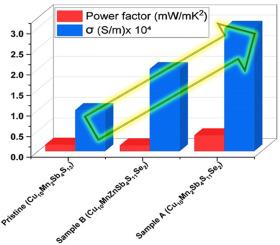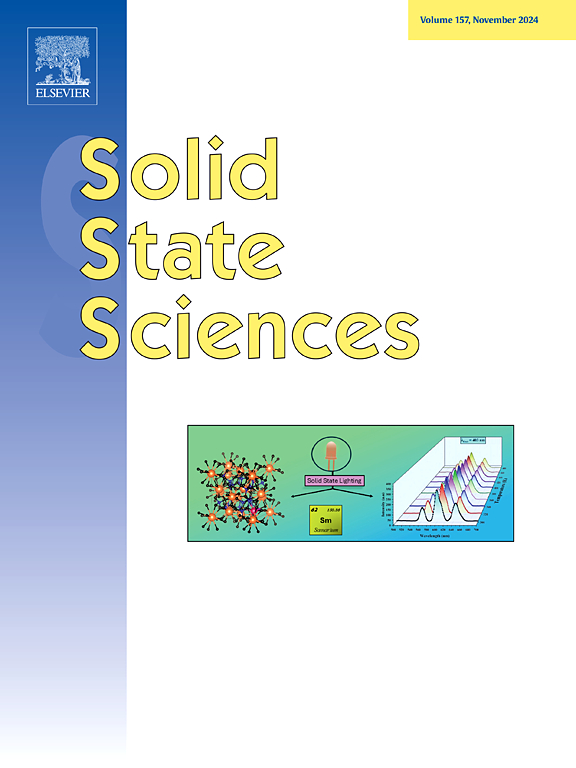Achieving enhanced power factor using dual substitution at Cu and S sites in tetrahedrites thermoelectric materials Cu12Sb4S13
IF 3.4
3区 化学
Q2 CHEMISTRY, INORGANIC & NUCLEAR
引用次数: 0
Abstract
Thermoelectric (TE) materials-based devices are valuable for translating heat into electricity, but the cost is largely driven by the use of purified metals required for efficient TE performance. This study focuses on tetrahedrite materials, which are cost-effective due to their abundance in copper ore mining waste and status as one of the most widespread sulfosalts on Earth. The research investigates the effects of co-doping and iso-valent doping on the TE properties of p-type tetrahedrite samples, specifically Cu10Mn2Sb4S11Se2 (Sample A) and Cu10MnZnSb₄S11Se2 (Sample B). These samples were synthesized using hot pressing at 773 K and compared with the existing pristine compound (Cu10Mn2Sb4S13). Doping with Mn and Zn (1:1) at the Cu site was found to optimize carrier concentration and enhance phonon scattering, leading to an improved power factor. Additionally, the Se substitution at the S site also introduced band degeneracy, further increasing the power factor. Further, sample B exhibited the highest Seebeck coefficient (∼300 μV/K) at 650 K, in comparison to Sample A (∼225 μV/K) and the pristine compound (∼250 μV/K). On the other hand, Sample A demonstrated significantly higher electrical conductivity (∼0.76 × 10⁴ S/m at 650 K), ∿ three times greater than that of the other prepared samples. Notably, the power factor of Sample A (∼0.389 mW/mK2 at 650 K) was more than twice that of Sample B (∼0.141 mW/mK2) and the pristine compound (∼0.160 mW/mK2). These findings suggest that dual-site substitution at the Cu and S positions presents a promising strategy to augment the TE performance of tetrahedrite compounds.

利用四面体热电材料 Cu12Sb4S13 中 Cu 和 S 位点的双重置换来提高功率因数
基于热电(TE)材料的设备在将热能转化为电能方面具有重要价值,但其成本在很大程度上取决于使用高效热电性能所需的纯化金属。本研究的重点是四面体材料,由于其大量存在于铜矿废料中,并且是地球上最常见的硫化物之一,因此成本效益很高。研究调查了共掺杂和同价掺杂对 p 型四面体样品 TE 性能的影响,特别是 Cu10Mn2Sb4S11Se2(样品 A)和 Cu10MnZnSb₄S11Se2(样品 B)。这些样品是在 773 K 下通过热压合成的,并与现有的原始化合物(Cu10Mn2Sb4S13)进行了比较。研究发现,在 Cu 位点掺入 Mn 和 Zn(1:1)可优化载流子浓度并增强声子散射,从而提高功率因数。此外,在 S 位点硒的替代也引入了带变性,进一步提高了功率因数。此外,与样品 A(∼225 μV/K)和原始化合物(∼250 μV/K)相比,样品 B 在 650 K 时显示出最高的塞贝克系数(∼300 μV/K)。另一方面,样品 A 的导电率明显更高(650 K 时为 0.76 × 10⁴ S/m),是其他制备样品的三倍。值得注意的是,样品 A 的功率因数(650 K 时为 0.389 mW/mK2)是样品 B(0.141 mW/mK2)和原始化合物(0.160 mW/mK2)的两倍多。这些研究结果表明,在 Cu 和 S 位置进行双位取代是提高四面体化合物 TE 性能的一种可行策略。
本文章由计算机程序翻译,如有差异,请以英文原文为准。
求助全文
约1分钟内获得全文
求助全文
来源期刊

Solid State Sciences
化学-无机化学与核化学
CiteScore
6.60
自引率
2.90%
发文量
214
审稿时长
27 days
期刊介绍:
Solid State Sciences is the journal for researchers from the broad solid state chemistry and physics community. It publishes key articles on all aspects of solid state synthesis, structure-property relationships, theory and functionalities, in relation with experiments.
Key topics for stand-alone papers and special issues:
-Novel ways of synthesis, inorganic functional materials, including porous and glassy materials, hybrid organic-inorganic compounds and nanomaterials
-Physical properties, emphasizing but not limited to the electrical, magnetical and optical features
-Materials related to information technology and energy and environmental sciences.
The journal publishes feature articles from experts in the field upon invitation.
Solid State Sciences - your gateway to energy-related materials.
 求助内容:
求助内容: 应助结果提醒方式:
应助结果提醒方式:


